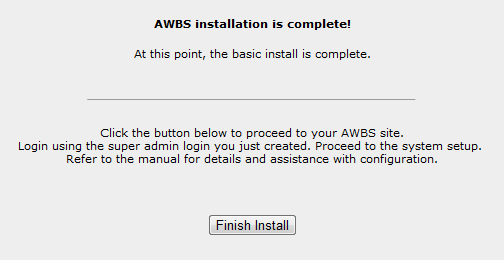Difference between revisions of "Easy Plesk Install"
(→Upload files) |
(→Upload files) |
||
| Line 23: | Line 23: | ||
# Click on the File Manager icon. <br/>[[Image:Plesk-FileManagerIcon.png]] | # Click on the File Manager icon. <br/>[[Image:Plesk-FileManagerIcon.png]] | ||
# In the directory listing click on the '''httpdocs''' link. ''(This tutorial assumes you are installing in the root of your site.)''<br/>[[Image:Plesk-httpdocs.png]] | # In the directory listing click on the '''httpdocs''' link. ''(This tutorial assumes you are installing in the root of your site.)''<br/>[[Image:Plesk-httpdocs.png]] | ||
| − | # Click on | + | # Click on the '''Add New File''' icon: <br/>[[Image:Plesk-AddNewFile.png]] |
| − | # | + | # Make sure the '''Upload a File''' option is selected, Then click the '''Choose File''' button to browse for and select the AWBS Full install Zip you have downloaded from AWBS.<br/>[[Image:Plesk-UploadFile.png]] |
| − | # | + | # In the Line Breaks option make sure '''do not modify''' is selected. Then click the '''Ok''' Button. |
| − | # | + | # Once that is completed click the '''Add New File''' icon again and choose the license.dat file you got when you purchased AWBS. |
| − | # When the | + | # In the Line Breaks option make sure '''do not modify''' is selected. Then click the '''Ok''' Button. |
| − | # | + | # When the uploads are complete, click on the checkbox beside the AWBS full install zip. <br/>[[Image:Plesk-AWBSCheckboxFile.png]] |
| − | + | # Then in the top options above the directory listing click the '''Extract Files''' link <br/>[[Image:Plesk-ExtractFilesIcon.png]] | |
---- | ---- | ||
Revision as of 13:28, June 23, 2011
Contents
[hide]Easy Plesk Install
(Note: this page is based on Plesk 10. Icons and links may have different but similar names/icons if you are using a different version of Plesk)
Login to Plesk
Create Database
- Click Websites & Domains tab in the top menu:

- Click the Databases Icon.
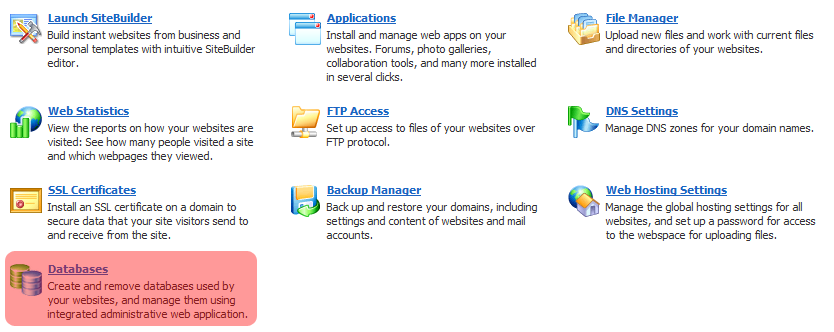
- Click the Add New Database on the Databases page:

- Enter the desired database name in the Database Name field, and Type is set to mySQL

- Click the Ok button.
- On the next page click on the Add New Database User icon.
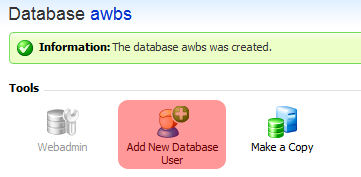
- Enter the Database username you would like to use, as well as a password.

- Click the Ok button.
- Document your db name, username and password for future reference.
Upload files
- Click back to the Websites & Domains tab in the top menu:

- Click on the File Manager icon.
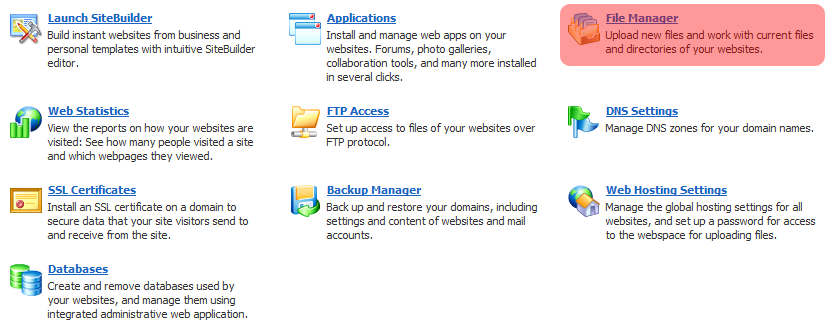
- In the directory listing click on the httpdocs link. (This tutorial assumes you are installing in the root of your site.)

- Click on the Add New File icon:
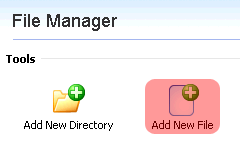
- Make sure the Upload a File option is selected, Then click the Choose File button to browse for and select the AWBS Full install Zip you have downloaded from AWBS.
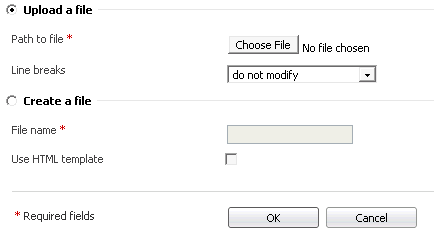
- In the Line Breaks option make sure do not modify is selected. Then click the Ok Button.
- Once that is completed click the Add New File icon again and choose the license.dat file you got when you purchased AWBS.
- In the Line Breaks option make sure do not modify is selected. Then click the Ok Button.
- When the uploads are complete, click on the checkbox beside the AWBS full install zip.

- Then in the top options above the directory listing click the Extract Files link

Edit dbconfig.php file
- Refresh the File Manager page.
- Navigate into the includes directory by clicking the folder icon beside includes:

- Scroll down in the listing until you find dbconfig.php.
Click on the filename dbconfig.php:
- In the top right pane, click Edit File with Code Editor.
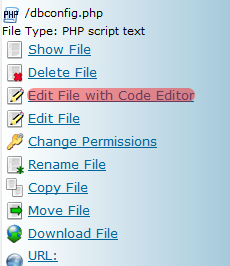
- This block will open a new box which asks for the character encoding, it is best to leave it at us-ascii:
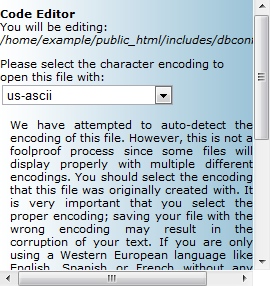
- Scroll down in this block until you see the Edit button. Click the Edit button:

- Find and Remove the $needs_edit=1; line:

- Find the Database information lines. This is where you will need the Database Name, Username, and Password as previously noted in the Create Database section.

- Edit these lines with your database information:

(Enter your information between the quotes in each line, overwriting the sample data that is there) - Find the Workdir information line:

- Edit this line with your correct path to your files:

Most cPanel servers paths would be like this:/home/userdir/public_html Substitute 'userdir' with your cPanel login username. - Find the Cookie Domain information line:

- Edit this line with your domain name preceded by a dot:

- Click the Save Changes button in the top right corner to save your dbconfig.php file:

- Close the edit window.
Run the install script
Open a new browser window. Surf to http://[your_AWBS_domain]/install/install.php (Substitute your domain name for [your_AWBS_domain])
Note: You must have read the AWBS license agreement and agree to abide by the terms to continue with the install.
Once you have read the license agreement, Check the box and click Begin Install
Welcome: (License Check)
The next step is to verify your license. You should see something like the following:
Once the license has been verified click the box at the bottom of the page labelled Continue With Install
Note: Error 5 indicates the license.dat file is missing. Be sure you have uploaded the license.dat file to the same directory that you uploaded the AWBS files.
Error 3 indicates your server cannot reach our license database via port 80. Ensure your server has internet access via port 80.
Step 1:
The next step is to check your php.ini configuration settings and make sure everything is ready to go.
You should see something like the following:

Once the above information has been tested, click the box at the bottom of the page labelled Continue to step 2
Step 2:
The next step is to check your database settings and make sure everything is ready to go.
You should see something like the following:

Once the above information has been tested, click the box at the bottom of the page labelled Continue to step 3
Step 3:
The next step is to check your database structure and make sure the database is ready to go.
You should see something like the following:

Once the above information has been tested, click the box at the bottom of the page labelled Continue to step 4
Step 4:
The next step is to populate the database with your company's information. Fill in the following info and then continue.
You will need to fill out the information shown below:
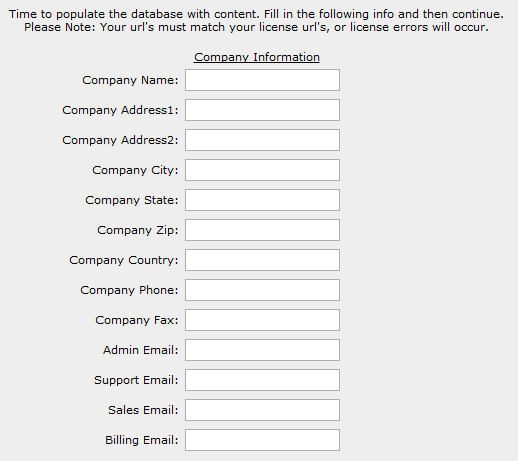
Server Settings
Edit the licensed urls if necessary. Add/Remove the www. as needed/desired, edit http and https as needed, and add any subdirectory information to the url. Do NOT add a trailing slash. If you don't have a secure site, use the same URL in both fields.
Do NOT enter a URL that does not contain your AWBS files! The URL must point to where you have uploaded the files.
If you alter the licensed domain name or subdomain, it will not match your license and you will have license errors.

Non-Secure URL: examples: http://[your_licensed_domain_name]/directory or http://[your_licensed_domain_name] or http://[your_licensed_subdomain]
Note: The URL above should reflect the URL you surf to to get to your AWBS site.
If making use of Portal Mode, select that option and enter the URL for your Front End site.
Server Admin
This is where you will establish the 'super admin' account and login. The password can be changed later.
Remember this login!
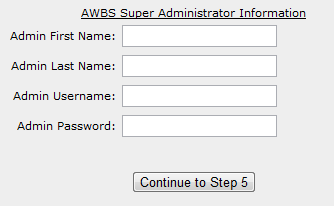
Once you have the above information filled out as needed, click the box at the bottom of the page labelled Continue to step 5
Step 5:
AWBS installation is complete!
At this point, the basic install is complete.
Click the box labeled "Finish Install"
Delete the install directory
- Go back to your cPanel File Manager browser window.
- Click on the Up one level link.

- Click on the install directory name (not icon).

- In the top right pane, click to delete this folder and all files under it link.
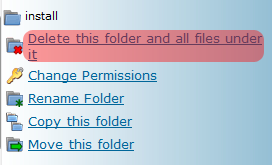
Secure the admin, includes and tools directories
- In cPanel, close the file manager window. Click the Password Protect Directories icon.

- In the Directory Selection box, use the Web Root.
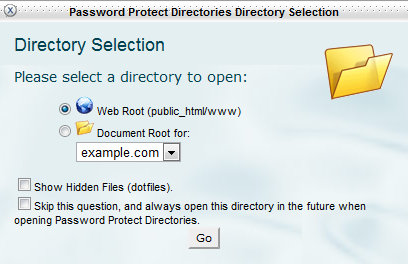
- Click on the admin directory name (not icon)

- Check the Directory requires a password to access via the web check box, (you must check this to activate password protection).

- Enter some text as desired in the Protected Resource Name (will display in browser's password mask)
- Click the Save button.
- If successful you should see the following. Click the Go Back link.

- Scroll down to the Active Users section.

- Enter a username in the User Name field and a password in the Password field.
- If successful you should see the following. Click the Go Back link.

- Additional users can be added.
- Click the Add/modify authorized user button.
Remember these logins will be needed by all who enter the protected directory. This will include any AWBS users who you give any admin rights to.
Repeat above for the includes and tools directories.
Configure your cron jobs
- From your cPanel home page, click on the cron jobs icon.
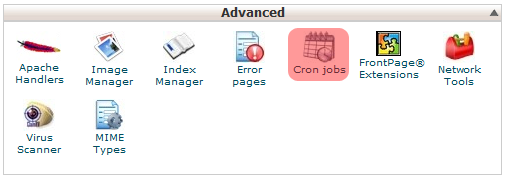
- Enter an email address you will be able to check in the Please enter an email address where the cron output will be sent field.

- Edit the Minute and Hour fields so that you have scheduled for once per day at a low traffic time on your server. Example: If you enter 0 for Minute and 5 for Hour, this will run the updtransfers.php cron at 5:00 AM each day.
- Enter php -f /home/userdir/public_html/tools/updtransfers.php in the Command field. (Substitute your cPanel username in place of 'userdir' and do not paste the quotes)

- Click the Add New Cron Job button.
- Configure the updateexp.php and invoice_cron.php files also for once per day, but at a different time than the updtransfers.php cron. You can copy the command field from the original, then just edit the file name updtransfers.php to updateexp.php and change the Hour, then save.
- Repeat for invoice_cron.php.
NOTE: It is advised to run the invoice_cron.php after the updateexp.php and updtransfers.php files each day. - Repeat for master_cron.php, however change the Minute field to */10 and the Hour field to *. This will run the master_cron.php every 10 minutes.
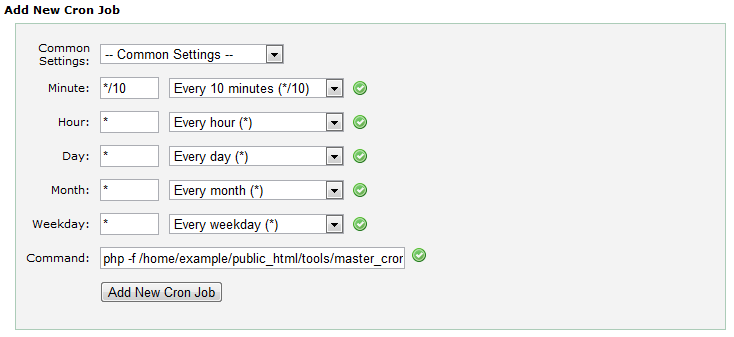
Once you are satisfied your crons are functioning properly (after configuring and testing your AWBS install), you can remove your email address to minimize your incoming emails.
Installation is complete, now you can login as super admin and start configuring, customizing and testing.

